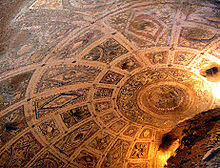
Lupercal
Encyclopedia

Cave
A cave or cavern is a natural underground space large enough for a human to enter. The term applies to natural cavities some part of which is in total darkness. The word cave also includes smaller spaces like rock shelters, sea caves, and grottos.Speleology is the science of exploration and study...
at the foot of the Palatine Hill
Palatine Hill
The Palatine Hill is the centermost of the Seven Hills of Rome and is one of the most ancient parts of the city...
in Rome
Rome
Rome is the capital of Italy and the country's largest and most populated city and comune, with over 2.7 million residents in . The city is located in the central-western portion of the Italian Peninsula, on the Tiber River within the Lazio region of Italy.Rome's history spans two and a half...
, between the Temple of Apollo Palatinus
Temple of Apollo Palatinus
The Temple of Apollo Palatinus was a temple on the Palatine Hill of ancient Rome, which was first dedicated by Augustus to his patron god Apollo. It was only the second temple in Rome dedicated to the god, after the Temple of Apollo Sosianus...
and the Basilica of Santa Anastasia
Santa Anastasia
Santa Anastasia is a basilica church in Rome, Italy.Santa Anastasia was built in the late 3rd century - early 4th century, possibly by a Roman woman named Anastasia. The church is listed under the titulus Anastasiae in the acts of the 499 synod...
. In the legend of Rome's foundation
Founding of Rome
The founding of Rome is reported by many legends, which in recent times are beginning to be supplemented by scientific reconstructions.- Development of the city :...
, Romulus and Remus
Romulus and Remus
Romulus and Remus are Rome's twin founders in its traditional foundation myth, although the former is sometimes said to be the sole founder...
were found there by the lactating female wolf who suckled them until they were found by Faustulus
Faustulus
In Roman mythology, Faustulus was the shepherd who found the infants Romulus and Remus, who were being suckled by a she-wolf, known as Lupa, on the Palatine Hill. He, with his wife, Acca Larentia, raised the children. In some versions of the myth, Larentia was a prostitute...
. The priests of Lupercus
Lupercus
Lupercus of Berytus was a Greek grammarian. He wrote On the Word, The Foundation of Arsinoe in Egypt, and more.- References :http://www.stoa.org/sol-bin/search.pl?search_method=QUERY&login=guest&enlogin=guest&page_num=1&user_list=LIST&searchstr=Arsinoe&field=any&num_per_page=25&db=REAL...
later celebrated certain ceremonies of the Lupercalia
Lupercalia
Lupercalia was a very ancient, possibly pre-Roman pastoral festival, observed on February 13 through 15 to avert evil spirits and purify the city, releasing health and fertility...
there; from the late years of the Republic
Roman Republic
The Roman Republic was the period of the ancient Roman civilization where the government operated as a republic. It began with the overthrow of the Roman monarchy, traditionally dated around 508 BC, and its replacement by a government headed by two consuls, elected annually by the citizens and...
until AD 494, when the practice was ended by Pope Gelasius I
Pope Gelasius I
Pope Saint Gelasius I was pope from 492 until his death in 496. He was the third and last bishop of Rome of African origin in the Catholic Church. Gelasius was a prolific writer whose style placed him on the cusp between Late Antiquity and the Early Middle Ages...
.
Modern discovery
In January 2007, Italian archaeologist Irene Iacopi announced that she had probably found the legendary cave beneath the remains of Emperor AugustusAugustus
Augustus ;23 September 63 BC – 19 August AD 14) is considered the first emperor of the Roman Empire, which he ruled alone from 27 BC until his death in 14 AD.The dates of his rule are contemporary dates; Augustus lived under two calendars, the Roman Republican until 45 BC, and the Julian...
's house, the Domus Livia
Livia
Livia Drusilla, , after her formal adoption into the Julian family in AD 14 also known as Julia Augusta, was a Roman empress as the third wife of the Emperor Augustus and his adviser...
, on the Palatine. Archaeologists came across the 15-meter-deep cavity while working to restore the decaying palace.
On 20 November 2007 the first set of photos were released showing the vault of the cave which is encrusted with colourful mosaics, pumice stones and seashells. The center of the ceiling features a depiction of a white eagle, the symbol of the Roman Empire during the reign of Augustus, the first Roman emperor. Archaeologists are still searching for the entrance of the grotto.

Augustus
Augustus ;23 September 63 BC – 19 August AD 14) is considered the first emperor of the Roman Empire, which he ruled alone from 27 BC until his death in 14 AD.The dates of his rule are contemporary dates; Augustus lived under two calendars, the Roman Republican until 45 BC, and the Julian...
, had considered taking the name Romulus
Romulus
- People:* Romulus and Remus, the mythical founders of Rome* Romulus Augustulus, the last Western Roman Emperor* Valerius Romulus , deified son of the Roman emperor Maxentius* Romulus , son of the Western Roman emperor Anthemius...
to indicate that he intended to found Rome anew.
Opposite opinions
Adriano La Regina (former Rome’s archaeological superintendent 1976-2004, professor of Etruscology at Rome’s La Sapienza University), Professor Fausto Zevi (professor of Roman Archaeology at Rome's La Sapienza University) and Professor Henner von Hesberg (head of the German Archaeological Institute, Rome) denied the identification of the grotto with Lupercal on topographic and stylistic grounds. They concluded that the grotto is actually a nymphaeumNymphaeum
A nymphaeum or nymphaion , in ancient Greece and Rome, was a monument consecrated to the nymphs, especially those of springs....
or underground triclinium
Triclinium
A triclinium is a formal dining room in a Roman building. The word is adopted from the Greek τρικλίνιον, triklinion, from τρι-, tri-, "three", and κλίνη, klinē, a sort of "couch" or rather chaise longue...
from Neronian times.

